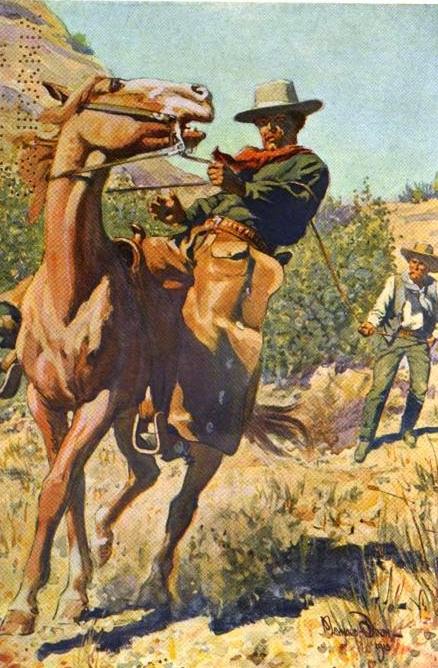| Magazine cover, 1904, Maynard Dixon |
Last week I blogged one day about the artist Maynard Dixon, with
examples of his book illustration for several novels. Today I
have gathered some of his illustrations for the western novels of another writer, Clarence E.
Mulford (1883–1956), best known as the originator of the character Hopalong
Cassidy.
Cassidy had already been portrayed by another illustrator, Frank
Schoonover for a story, “The Fight at Buckskin,” first published in the
December 1905 issue of Outing Magazine
and later appearing as the opening chapter of Mulford’s Bar-20 (1907).
The bunch of Texas cowboys at the Bar-20 comprised the dramatis personae
of a series of Mulford novels, following the example of B. M. Bower, who had
her own set of recurring characters from a Montana ranch, the Flying U.
Schoonover, who had travelled in the West specifically to soak up cowboy local color for his painting, gives Hopalong what seems to be an authentic lived-in costume, with full mustache and a beat-up hat. See here.
Dixon is more interested in the romance of his subject matter, using
visual composition, light, shadow, and movement to capture moments of drama and
mystery. Some scenes take place in the half-light of dusk or a night sky. Guns are often drawn or are being fired.
A man on a horse is observed
from the top of a high bluff by another rider holding a rifle. A woman walks
cautiously toward a fallen cowboy, lying near a downed horse, while around them
the desert is alive with blooming flowers. (Notice the horizon line near the top of the picture and the placement of the man near the bottom, as if he is about to slip off the page altogether.) Horses themselves often display the
charge of energy and excitement that quickens a scene.
For the customer in a turn-of-the-century bookstore, these illustrations
must have done much to appeal to curiosity, the imagination, and the pocketbook. I would surely like my westerns to come illustrated like this today.
Bar-20 Days (1911)
The Coming of Cassidy (1913)
Shamelsss
plug: For an in-depth survey of early writers of frontier fiction, read How the West Was Written (to obtain a copy, click here).
Image credits:
Wikimedia Commons
Google books
Coming up: Francis Lynde, Empire Builders (1907)













Thanks for this. I downloaded a free ebook copy of the Bar-20 stories years ago but no illustrations, of course. These go nicely.
ReplyDeleteIf they did that today, it would probably put the book out of range price-wise. Great illustrations.
ReplyDeleteNo doubt.
DeleteMaynard Dixon's work is just wonderful and for the first time in 75 years I have an interest in reading one of Mr. Mulford's Cassidy story's.
ReplyDeleteDixon really brought those stories vividly to life.
DeleteHis later paintings, which sometimes appear on Antiques Roadshow, are mostly of desert and mountain scenery with the sky dominating, with seldom any figures in the paintings, or very small , dominated by land and sky. His depictions of people have so much energy. Perhaps he considered these as only commercial art, and the others as serious art.
ReplyDeleteI think your last statement is probably close to the mark. I've read that he had a special affection for the Four Corners area and would spend long periods of time there to soak up inspiration for his painting.
DeleteText boxes will give your document a more exciting and professional appearance. As a result, you should incorporate text boxes and graphics into your presentations. In Google Docs, creating and customizing text boxes is easy. To add text boxes to your paper, you can use the drawing tool or the single-cell table. Create text boxes in Google Docs with ease by following our step-by-step instructions. Finally, brush up on your Google Docs skills by learning how to strikethrough. If you are still having trouble posting on Instagram after following this guide. I will try to respond and help you as soon as possible, contact us via Bellen Google Nederland.
ReplyDelete